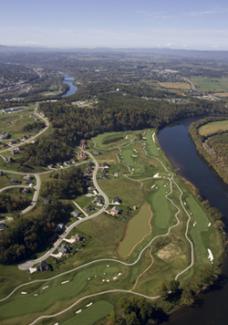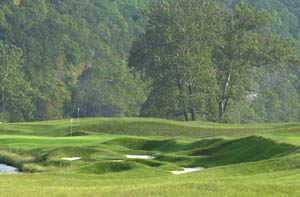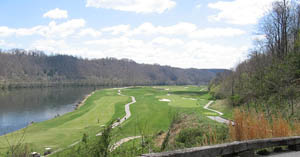Featured Golf News
Down by the River - Dye's Course at Virginia Tech
The first thing players notice about the Pete Dye-designed River Course of Virginia Tech is - appropriately - the fact that the course is dominated by the nearby New River.

Aerial View of River Course
The refashioned River Course resides alongside two and half miles of the New River in southwestern Virginia in Radford, about 15 minutes from the Virginia Tech campus in Blacksburg. The 18-hole, par-72 track is bisected by a 70-foot rock cliff that allowed Dye to route two divergent but complimentary nine-hole loops which start and finish below the massive clubhouse. Fourteen of the course's holes offer views of the New River and eight actually play along the edge of the swiftly flowing stream.
Dye's creation - which supplanted a five-year-old layout fashioned by Brian Ault and Tom Clark - opened in 2005 and plays to 7,665 yards from the tips. The course occupies a nice piece of land with a backdrop of water, mountains and trees and offers players isolation and challenge.
The renovation - Dye called it a "blow-it-up-and-start-over situation" - was championed by Bill Goodwin, a noted Virginia Tech supporter perhaps best known for developing Kiawah Island Resort in South Carolina (also a Dye design). Goodwin wanted VT to have a top-notch facility for the university's golf teams and hoped to create a good enough course to host NCAA events.

Pete Dye River Course of Virginia Tech
In the remodel Dye and his team moved 400,000 cubic yards of earth and repositioned and re-routed nearly all the holes. He started the project by removing hundreds of box elders that choked the edges of the river. But the team left the sycamores in place because they liked the contrast and beauty these trees lent. The result seems to narrow the course but actually allows balls headed for the river to find a respite in mounds under the trees. The work also provides for better views of the river from fairways and tee boxes.
The revamped layout also sports thousands of new trees, especially on the bluff below the clubhouse. Once they mature the course will be even more picturesque.
Dye built mounding between River Course's holes, separating them from each other while creating an illusion of solitude despite the property's compactness. He also reduced the size of the putting surfaces and surrounded them with areas where wayward shots will collect, requiring the player to have excellent short-game skills if missing the greens.

River Course's 10th & 18th holes
Accuracy on Approaches is the Key
Some might say that the River Course is now in perfect balance; each of its par-3s play in a different direction and the 10 par-4s and four par-5s require a variety of shots, with seven playing left-to-right and seven moving right-to-left.
The combination of distance and direction, set among these primitive rock faces, Dye-trademark pot bunkers and the nearby gently rolling river present a thorough golf experience.
The putting surfaces at River Course are small and kidney-shaped and become very narrow in the back, giving the course flexibility in its setup. "Pete designed narrow sections in the backs of the greens where we can put the holes and make the course play really tough," said John Norton, the River Course's general manager and head PGA professional.
"If we put the pins in front, you can run the ball up, and it'll play much easier for average players and women. It's a course that can be friendly, and at the same time, can be very tough."
And the River Course's greens are relatively flat. "Pete told us you can no longer 'bury elephants' in the greens when you're trying to get the speeds up to 11 and 12 on the Stimpmeter."
So the real challenge at the River Course comes from the fairway, as getting your approach close to the day's hole location is essential. There's only one forced carry over a bunker, and that's on the par-3 seventh, which plays 159 yards from the back tee. Every other hole is open in front to promote run-up options.
After tackling the massive 475-yard par-4 second, players get their first real look at the New River on No. 3, a 588-yard par-5 that typically plays into the wind. The entire port side of the hole is flanked by the river, and its final 200 yards are separated from the water by a deep and narrow bunker.
The 497-yard par-4 fourth also has character. It's a dogleg-left with a pond in the bend to deal with on the approach. Nos. 8 and 9 head back to the river. The eighth is a slight dogleg-right, 426-yard par-4 that moves away from the New River to a demanding four-tiered green. No. 9 plays at 579 yards from the tips and requires great shots to avoid bunkers right of the fairway off the tee and to reach a thin green that has a slight swale through its midsection.

River Course's Clubhouse & 18th Green
The 488-yard par-4 11th is bordered left on the approach by a large lake and its green slopes severely back to front. The River Course ends with the 243-yard par-3 17th and the 495-yard par-5 18th, two massive challenges on an already taxing track. No. 17 has a deep bunker along its entire right side and the river sweeps by on the other side of the sand, forcing any miss to be to the left. There's even a pot bunker if you miss short and right.
The closer is another Dye classic - narrow off the tee to an undulating fairway that ends with a putting surface protected by three deep bunkers and angled toward the river on the right. At nearly 500 yards, many players will choose to take danger out of play and hit both their first and second shots left to stay dry, but the bold will play down the right to shorten the approach.
A real treat is playing the River Course in the late afternoon, in the hours before dusk, as its bumps and rolls and angles and edges come to life. Dye's work here is best characterized by the way he's let Mother Nature do the talking. She is, after all, the ultimate golf course designer.
Off the Course
To complete your "Hokie" experience, stay a night or two at the Inn at Virginia Tech, with its casual elegance and fine accommodations. Set on the campus of Virginia Tech, the Inn is the perfect destination to explore all of Virginia Tech, Blacksburg, Virginia and Montgomery County, and still get away from it all.
The Inn at Virginia Tech and its adjacent Skelton Conference Center is the largest hotel and conference center in Blacksburg, with 24,000 square feet of conference space (including a 700-seat ballroom), 10 conference rooms and 147 hotel rooms and suites. The Inn is one of the premier facilities in the entire mid-Atlantic region.
For more information, visit www.petedyerivercourse.com.
Steve Habel is one of Cybergolf's national correspondents, contributing news stories, features, equipment and book reviews and personality profiles from his base in Central Texas. He is also the managing editor for Texas CEO Magazine and works as a contributing editor for Horns Illustrated magazine, a publication focusing on University of Texas sports. He also writes a blog (www.shotoverthegreen.blogspot.com), which features news on golf and the Longhorns, and another (www.checkinginandplayingthrough.blogspot.com) on his many travels, which took him across the nation and to 105 different golf course in 2009. Habel is a member of the Golf Writers Association of America and the Texas Golf Writers Association.
Story Options
 |
Print this Story |
